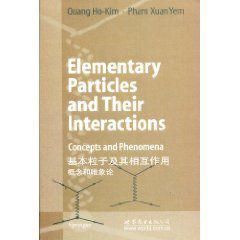內容簡介
 基本粒子及其相互作用:概念和唯象論
基本粒子及其相互作用:概念和唯象論作者簡介
作者:(加拿大)金廣浩 Quang Ho-Kim Pham Xuan Yem
圖書目錄
1 Particles and Interactions:An Overview
1.1 A Preview
1.2 Particles
1.2.1 Leptons
1.2.2 Quarks
1.2.3 Hadrons
1.3 Interactions
1.4 Symmetries
1.5 Physical Units
Problems
Suggestions for Further Reading
2 B080n Fields
2.1 Lorentz Symmetry
2.1.1 Lorentz TraIlsformations
2.1.2 Tensor Algebra
2.1.3 llensor Fields
2.2 Scalar Fields
2.2.1 Space-Time Translation of a Scalar Field
2.2.2 Lorentz Transformation of a Scalar Field
2.3 Vector Fields
2.4 The Klein-Gordon Equation
2.4.1 Free-Patticle Solutions
2.4.2 Particle Probability
2.4.3 Second Quantization
2.4.4 Operator Algebra
2.4.5 Physical Significance of the Fock Operators
2.5 Quantized Vector Fields
2.5.1 Maesive Vector Fields
2.5.2 The Maxwell Equations
2.5.3 Quantization of the Electromagnetic Field
2.5.4 Field Energy and Momentum
2.6 The Action
2.6.1 The Euler-Lagrange Equation
2.6.2 Conserved Current
Problems
Suggestions for Further Reading
3 Fermion Fields
3.1 The Dirac Equation
3.2 Lorentz Symmetry
3.2.1 Covariance of the Dirac Equation
3.2.2 Spin of the Dirac Field
3.2.3 Bilinear Covariants
3.3 Free.Particle Solutions
3.3.1 Normalized Spinors
3.3.2 Completeness Relations
3.3.3 Helicities
3.4 The Lagrangian for a Free Dirac Particle
3.5 Quantization of the Dirac Field
3.5.1 Spins and Statistics
3.5.2 Dirac Field Observables
3.5.3 F0ck Space
3.6 Zero-Mass Fermions
Problems
Suggestions for Further Reading
4 Collisions and Decays
4.1 Interaction Representation
4.1.1 The Three Pictures
4.1.2 Time E:volution in the Interaction Picture
4.1.3 The S.matrix
4.2 Cross.Sections and Decay Rares
4.2.1 General Formulas
4.2.2 Two-Body Reaction to Two-Body Final States
4.2.3 Decay Rates
4.3 Interaction Models
4.4 Decay Modes of Scalar Particles
4.4.1 Neutral Decay Mode
4.4.2 Charged Decay Mode
4.5 Pion Scattering
4.5.1 The Scalar Boson Propagator
4.5.2 Scattering Processes
4.5.3 Summary and Generalization
4.6 Electron-Proton Scattering
4.6.1 The Electromagnetic Interaction
4.6.2 Electron-Proton Scattering Cross-Section
4.7 Electron-Positron Annihilation
4.8 Compton Scattering
Problems
Suggestions for Further Reading
5 Discrete Symmetries
5.1 Parity
5.1.1 Parity in Quantum Mechanics
5.1.2 Parity in Field Theories
5.1.3 Parity and Interactions
5.2 Time Inversion
5.2.1 Time Inversion in Quantum Mechanics
5.2.2 Time Inversion in Field Theories
5.2.3丁and Interactions
5.3 Charge Conjugation
5.3.1 Additive Quantum Numbers
5.3.2 Charge Conjugation in Field Theories
5.3.3 Interactions
5.4 The CPT Theorem
5.4.1 Implications of CPT Invariance
5.4.2 C.P,T.and CPT
Problems
Suggestions for Further Reading
6 Hadtons and Isospln
6.1 Charge Symmetry and Charge Independence
6.2 Nucleon Field in Isospin Space
6.3 Pion Field in Isospin Space
6.4 G.Parity
6.4.1 Nucleon and Pion Fields
6.4.2 Other Unflavored Hadrons
6.5 Isospin of Strange Particles
6.6 Isospin Violations
6.6.1 Electromagnetic Interactions
6.6.2 Wlealc Interactions
Problems
Suggestions for Further Reading
7 Quarks and SU(3)Symmetry
7.1 Isospin:SU(2) Symmetry
7.2 Hypercharge:SU(31 Symmetry
7.2.1 The Fundamental Representation
7.2.2 Higher.Dimensional Representations
7.2.3 Physical Significance of F3 and F3
7.2.4 3×3*Equal Mesons
7.2.5 3×3×3 Equal Baryons
7.3 Mass Splitting of the Hadron Multiplets
7.3.1 Baryons
7.3.2 Mesons
7.4 Including Spin:SU(6)
7.4.1 Mesons
7.4.2 Baryons
7.4.3 Application:Magnetic Moments of Hadrons
7.5 The Color of Quarks
7.6 The New Particles
7.6.1 J/tf,and Charm
7.6.2 The TaU Lepton
7.6.3 From Bottom to ToP
Problems
Suggestions for Further Reading
8 Gauge Field Theories
8.1 Symmetries and Interactions
8.2 Abelian Gauge Invariance
8.3 Non.Abelian Gauge Invariance
8.4 Quantum Chromodynamics
8.5 Spontaneous Breaking of Global Symmetries
8.5.1 The Basic Idea
8.5.2 Breakdown ofDiscrete Symmetry
8.5.3 Breakdown of Abelian Symmetry
8.5.4 Breakdown of Non-Abelian Symmetry
8.6 Spontaneous Breaking ofLocal Symmetries
8.6.1 Abelian Symmetry
8.6.2 Non.Abelian Symmetry
Problems
Suggestions for Further Reading
9 The Standard Model of the Electroweak Interaction
9.1 The Wleak Interaction Before the Gauge Theories
9.2 Gauge.Invariant Model of One.Lepton Family
9.2.1 Global Symmetry
9.2.2 Gauge Invariance
……
